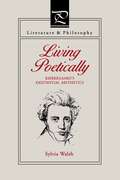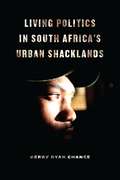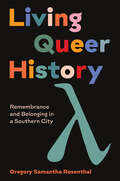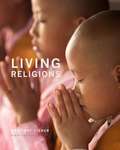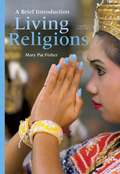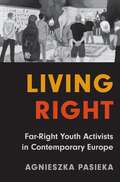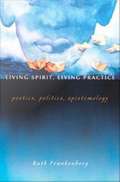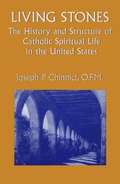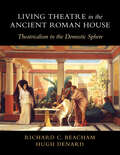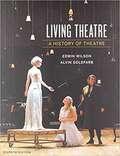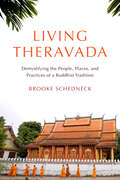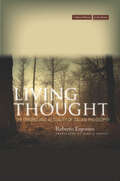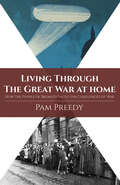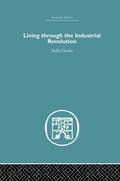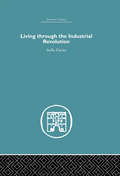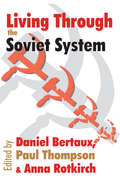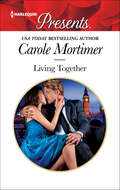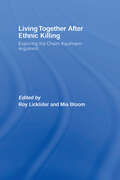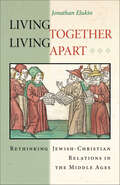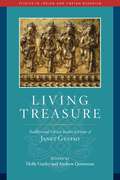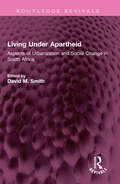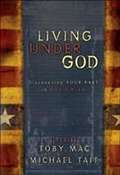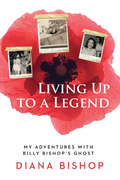- Table View
- List View
Living Pictures, Missing Persons: Mannequins, Museums, and Modernity
by Mark B. SandbergIn the late nineteenth century, Scandinavian urban dwellers developed a passion for a new, utterly modern sort of visual spectacle: objects and effigies brought to life in astonishingly detailed, realistic scenes. The period 1880-1910 was the popular high point of mannequin display in Europe. Living Pictures, Missing Persons explores this phenomenon as it unfolded with the rise of wax museums and folk museums in the largest cities of Denmark, Sweden, and Norway. Mark Sandberg asks: Why did modernity generate a cultural fascination with the idea of effigy? He shows that the idea of effigy is also a portal to understanding other aspects of visual entertainment in that period, including the widespread interest in illusionistic scenes and tableaux, in the "portability" of sights, spaces, and entire milieus. Sandberg investigates this transformation of visual culture outside the usual test cases of the largest European metropolises. He argues that Scandinavian spectators desired an unusual degree of authenticity--a cultural preference for naturalism that made its way beyond theater to popular forms of museum display. The Scandinavian wax museums and folk-ethnographic displays of the era helped pre-cinematic spectators work out the social implications of both voyeuristic and immersive display techniques. This careful study thus anticipates some of the central paradoxes of twentieth-century visual culture--but in a time when the mannequin and the physical relic reigned supreme, and in a place where the contrast between tradition and modernity was a high-stakes game.
Living Poetically: Kierkegaard's Existential Aesthetics (Literature and Philosophy)
by Sylvia WalshLiving Poetically is the first book to focus primarily on Kierkegaard's existential aesthetics as opposed to traditional aesthetic features of his writings such as the use of pseudonyms, literary techniques and figures, and literary criticism. Living Poetically traces the development of the concept of the poetic in Kierkegaard's writings as that concept is worked out in an ethical-religious perspective in contrast to the aesthetics of early German romanticism and Hegelian idealism. Sylvia Walsh seeks to elucidate what it means, in Kierkegaard's view, to be an authentic poet in the form of a poetic writer and to clarify his own role as a Christian poet and writer as he understood it. Walsh shows that, in spite of strong criticisms made of the poetic in some of his writings, Kierkegaard maintained a fundamentally positive understanding of the poetic as an essential ingredient in ethical and religious forms of life. Walsh thus reclaims Kierkegaard as a poetic thinker and writer from those who would interpret him as an ironic practitioner of an aestheticism devoid of and detached from the ethical-religious as well as from those who view him as rejecting the poetic and aesthetic on ethical or religious grounds.Viewing contemporary postmodern feminism and deconstruction as advocating a romantic mode of living poetically, Walsh concludes with a feminist reading of Kierkegaard that affirms both individuality and relatedness, commonalities and differences between the self and others, men and women, for the fashioning of an authentic mode of living poetically in the present age.
Living Politics in South Africa’s Urban Shacklands
by Kerry Ryan ChanceWhile much has been written on post-apartheid social movements in South Africa, most discussion centers on ideal forms of movements, disregarding the reality and agency of the activists themselves. In Living Politics, Kerry Ryan Chance radically flips the conversation by focusing on the actual language and humanity of post-apartheid activists rather than the external, idealistic commentary of old. Tracking everyday practices and interactions between poor residents and state agents in South Africa’s shack settlements, Chance investigates the rise of nationwide protests since the late 1990s. Based on ethnography in Durban, Cape Town, and Johannesburg, the book analyzes the criminalization of popular forms of politics that were foundational to South Africa’s celebrated democratic transition. Chance argues that we can best grasp the increasingly murky line between “the criminal” and “the political” with a “politics of living” that casts slum and state in opposition to one another. Living Politics shows us how legitimate domains of politics are redefined, how state sovereignty is forcibly enacted, and how the production of new citizen identities crystallize at the intersections of race, gender, and class.
Living Queer History: Remembrance and Belonging in a Southern City
by Gregory Samantha RosenthalQueer history is a living practice. Talk to any group of LGBTQ people today, and they will not agree on what story should be told. Many people desire to celebrate the past by erecting plaques and painting rainbow crosswalks, but queer and trans people in the twenty-first century need more than just symbols—they need access to power, justice for marginalized people, spaces of belonging. Approaching the past through a lens of queer and trans survival and world-building transforms history itself into a tool for imagining and realizing a better future. Living Queer History tells the story of an LGBTQ community in Roanoke, Virginia, a small city on the edge of Appalachia. Interweaving &8239;historical analysis, theory, and memoir, Gregory Samantha Rosenthal tells the story of their own journey—coming out and transitioning as a transgender woman—in the midst of working on a community-based history project that documented a multigenerational southern LGBTQ community. Based on over forty interviews with LGBTQ elders, Living Queer History explores how queer people today think about the past and how history lives on in the present.
Living Religions
by Mary FisherLiving Religions emphasizes the personal consciousness of believers and their own accounts of their religion and relevance in the present day. Mary Pat Fisher considers how the contemporary beliefs and practices of each of these traditions has evolved, and explores the changing nature of each religion. The ninth edition focuses on cultural customs, popular spiritual practices, mixtures of religions, and varieties of religions ways. Expanded coverage of women, including women's voices and contributions, is woven into the discussion of each religion. Living Religions provides a sympathetic approach to the historical teachings of traditional faiths, indigenous religions, and new religious movements. The text follows a clear and straightforward account of the development, doctrines, and practices of the major faiths followed today.
Living Religions: A Brief Introduction
by Mary Pat Fisher<p>Living Religions: A Brief Introduction 3/e presents a highly readable and stimulating concise survey of the modern religious world though an emphasis on the personal consciousness of believers and their own accounts of their religion and relevance in contemporary life. <p>Along with a team of specialist consultants in each faith, and drawing on a wealth of scholarly research and firsthand source material, Mary Pat Fisher provides a fresh and challenging insight into the historical development and teachings of traditional faiths, indigenous religions, and new religious movements. She considers how the contemporary beliefs and practices of each of these traditions has evolved, and explores the changing nature of each religion; particularly the role of women, and the issues and controversies such as fundamentalism, violence, globalization, and interfaith initiatives. </p>
Living Right: Far-Right Youth Activists in Contemporary Europe
by Agnieszka PasiekaA sobering look at the seductive power of fascist ideas for the youngRadical nationalism is on the rise in Europe and throughout the world. Living Right provides an in-depth account of the ideas and practices that are driving the varied forms of far-right activism by young people from all walks of life, revealing how these social movements offer the promise of comradery, purpose, and a moral calling to self-sacrifice, and demonstrating how far-right ideas are understood and lived in ways that speak to a variety of experiences.In this eye-opening book, Agnieszka Pasieka draws on her own sometimes harrowing fieldwork among Italian, Polish, and Hungarian militant youths, painting unforgettable portraits of students, laborers, entrepreneurs, musicians, and activists from well-off middle class backgrounds who have all found a nurturing home in the far right. Providing an in-depth account of radical nationalist communities and networks that are taking root across Europe, she shows how the simultaneous orientation of these groups toward the local and the transnational is a key to their success. With a focus on far-right morality that challenges commonly held ideas about the right, Pasieka describes how far-right movements afford opportunities to the young to be active members of tightly bonded comradeships while sharing in a broader project with global ramifications.Required reading for anthropologists and anyone concerned about the resurgence of far-right militancy today, Living Right sheds necessary light on the forces that have made the growing appeal of fascist idealism for young people one of the most alarming trends of our time.
Living Spirit, Living Practice: Poetics, Politics, Epistemology
by Ruth FrankenbergIn Living Spirit, Living Practice, the well-known cultural studies scholar Ruth Frankenberg turns her attention to the remarkably diverse nature of religious practice within the United States today. Frankenberg provides a nuanced consideration of the making and living of religious lives as well as the mystery and poetry of spiritual practice. She undertakes a subtle sociocultural analysis of compelling in-depth interviews with fifty women and men, diverse in race, ethnicity, national origin, class, age, and sexuality. Tracing the complex interweaving of sacred and secular languages in the way interviewees make sense of the everyday and the extraordinary, Frankenberg explores modes of communication with the Divine, the role of the body, the importance of geography, work for progressive social change, and the relation of sex to spirituality. Christians, Jews, Muslims, Buddhists, Hindus, and other practitioners come together here, speaking in terms both familiar and surprising. Whether discussing an Episcopalian deacon, a former Zen Buddhist who is now a rabbi, a Chicano monastic, an immigrant Muslim woman, a Japanese American Tibetan Buddhist, or a gay African American practicing in the Hindu tradition, Frankenberg illuminates the most intimate, local, and singular aspects of individual lives while situating them within the broad, dynamic canvas of the U. S. religious landscape.
Living Stones: The History and Structure of Catholic Spiritual Life in the United States (2nd edition)
by Joseph P. ChinniciLiving Stones was written from the perspective of a historian who experienced the changes in the community from 1950 to 1970, and who observed, suffered, enjoyed, and asked the questions peculiar to that particular post-World War II generation. If one experience was uppermost, it was that many of the participants in those changes experienced not simply the loss of this or that aspect of Catholic self-identity and practice (e.g. abstinence on Friday, the collapse of particular devotions, an increasing pluralism in the interpretation of the Church's moral norms), but the dissolution of a structure of belief, the collapse of a home constructed out of abstract principles, and a "scholasticism of the heart."
Living Theatre in the Ancient Roman House: Theatricalism in the Domestic Sphere
by Hugh Denard Richard C. BeachamFor the Romans, much of life was seen, expressed and experienced as a form of theatre. In their homes, patrons performed the lead, with a supporting cast of residents and visitors. This sumptuously illustrated book, the result of extensive interdisciplinary research, is the first to investigate, describe and show how ancient Roman houses and villas, in their décor, spaces, activities and function, could constitute highly-theatricalised environments, indeed, a sort of 'living theatre'. Their layout, purpose and use reflected and informed a culture in which theatre was both a major medium of entertainment and communication and an art form drawing upon myths exploring the core values and beliefs of society. For elite Romans, their homes, as veritable stage-sets, served as visible and tangible expressions of their owners' prestige, importance and achievements. The Roman home was a carefully crafted realm in which patrons displayed themselves, while 'stage-managing' the behaviour and responses of visitor-spectators.
Living Theatre: A History of Theatre
by Edwin Wilson Alvin GoldfarbFocused on the cultural relevance of theatre. Written in an engaging style. Designed to be accessible to undergraduates. Living Theatre is the most popular text for theatre history courses. The Seventh Edition builds on these strengths with “Past and Present”―a NEW feature that focuses on connections between theatre’s long history and the practice of theatre today―and with a brilliant NEW design that highlights the beauty and excitement of the art of theatre.
Living Theravada: Demystifying the People, Places, and Practices of a Buddhist Tradition
by Brooke SchedneckAn illuminating introduction to the contemporary world of Theravada Buddhism and its rich culture and practices in modern mainland Southeast Asia.Theravada translates as &“the way of the Elders,&” indicating that this Buddhist tradition considers itself to be the most authoritative and pure. Tracing all the way back to the time of the Buddha, Theravada Buddhism is distinguished by canonical literature preserved in the Pali language, beliefs, and practices—and this literature is often specialized and academic in tone. By contrast, this book will serve as a foundational and accessible resource on Theravada Buddhism and the contemporary, lived world of its enduring tradition. Brooke Schedneck has done extensive research on topics such as religions of Southeast Asia, contemporary Buddhism, gender in Asian religions, and religious tourism. Narrowing in on topics such as temples, monastic lives, lay Buddhists, meditation, and Buddhist objects, Schedneck highlights the thriving diversity of Theravada Buddhists today. Exploring Theravada as a lived religion reveals how people apply various expressions in everyday life. She presents to readers the most important practices and beliefs of Theravada Buddhists, illustrated through contemporary debates about what represents proper Theravada practice within Cambodia, Myanmar, Laos, and Thailand in the twenty-first century. Additionally, practical information is provided in appendices about what temples and practice centers readers can visit as well as a temple etiquette guide offering tips for being a respectful visitor. While academics will benefit from and appreciate this overview, the writing offers a refreshing introduction to a complex tradition for readers new to the subject.
Living Thought: The Origins and Actuality of Italian Philosophy
by Roberto EspositoThe work of contemporary Italian thinkers, what Roberto Esposito refers to as Italian Theory, is attracting increasing attention around the world. This book explores the reasons for its growing popularity, its distinguishing traits, and why people are turning to these authors for answers to real-world issues and problems. The approach he takes, in line with the keen historical consciousness of Italian thinkers themselves, is a historical one. He offers insights into the great "unphilosophical" philosophers of life-poets, painters, politicians and revolutionaries, film-makers and literary critics-who have made Italian thought, from its beginnings, an "impure" thought. People like Machiavelli, Croce, Gentile, and Gramsci were all compelled to fulfill important political roles in the societies of their times. No wonder they felt that the abstract vocabulary and concepts of pure philosophy were inadequate to express themselves. Similarly, artists such as Dante, Leonardo Da Vinci, Leopardi, or Pasolini all had to turn to other disciplines outside philosophy in order to discuss and grapple with the messy, constantly changing realities of their lives. For this very reason, says Esposito, because Italian thinkers have always been deeply engaged with the concrete reality of life (rather than closed up in the introspective pursuits of traditional continental philosophy) and because they have looked for the answers of today in the origins of their own historical roots, Italian theory is a "living thought. " Hence the relevance or actuality that it holds for us today. Continuing in this tradition, the work of Roberto Esposito is distinguished by its interdisciplinary breadth. In this book, he passes effortlessly from literary criticism to art history, through political history and philosophy, in an expository style that welcomes non-philosophers to engage in the most pressing problems of our times. As in all his works, Esposito is inclusive rather than exclusive; in being so, he celebrates the affirmative potency of life.
Living Through Perestroika: The Soviet Union in Upheaval, 1985-1991 (Bedford Document Collection )
by Robert W. StrayerThis document collection will help students make connections between individuals' responses to the demise of Soviet communism and their economic, political, and social position within Soviet society during the Gorbachev era (1985-1991). Students are guided through their analysis of the primary sources with an author-provided learning objective, central question, and historical context.
Living Through The Great War at Home: How the People of Bromley Faced the Challenges of War
by Pam PreedyLiving Through the Great War at Home tells the story of the people of Bromley from the month before the outbreak of war to the Armistice in 1918 and the celebration of peace in July 1919. Although it shows how men were mobilised, volunteered, conscripted and left to ‘follow the colours’, it is a book about the people of Bromley and how their lives were challenged and changed during the war, how they supported their own boys in the army, how they dealt with the problems of war, the restrictions of DORA (Defence of the Realm Act) and the threat and reality of the Zeppelin raids. We learn of the generosity of the people in supporting their ‘boys’, caring for the Belgian refugees and the wounded—the VAD hospitals and how women rose to the challenge, both in terms of filling the gaps in the workforce left by the men and struggling to put food on the table as rising prices and shortages finally led to rationing. The work is based on real information from the local newspaper, together with research to put them into context and understand the stories better.
Living Through the Industrial Revolution
by Stella DaviesFirst published in 1966, this revealing study looks closely into the lives of the men, women and children working in mines, workshops, factories and farms during the industrial revolution. It investigates the inventors whose new machines made the industrial revolution possible, and reflects on the new type of employer whose enterprise and energy in linking machine and labour power formed a new society. Where possible, contemporary accounts, letters, diaries and reports have been used so that the words of those living through this remarkable time can be heard - the words and thoughts of masters, workpeople, apprentice children, 'improving landlords' and farm labourers illuminate the prevailing attitudes of the period. An introductory chapter outlines previous methods of living and working and shows the first movements towards the industrial revolution. Describing successes and failures, lives of impoverishment and hardship, fortunes made and, sometimes, lost, and the effects of the new society, this enlightening study investigates how early struggles to cope with almost overwhelming problems are now seen as the beginnings of the comparatively comfortable conditions we benefit from today.
Living Through the Industrial Revolution
by Stella DaviesFirst published in 1966, this revealing study looks closely into the lives of the men, women and children working in mines, workshops, factories and farms during the industrial revolution. It investigates the inventors whose new machines made the industrial revolution possible, and reflects on the new type of employer whose enterprise and energy in linking machine and labour power formed a new society. Where possible, contemporary accounts, letters, diaries and reports have been used so that the words of those living through this remarkable time can be heard - the words and thoughts of masters, workpeople, apprentice children, 'improving landlords' and farm labourers illuminate the prevailing attitudes of the period. An introductory chapter outlines previous methods of living and working and shows the first movements towards the industrial revolution. Describing successes and failures, lives of impoverishment and hardship, fortunes made and, sometimes, lost, and the effects of the new society, this enlightening study investigates how early struggles to cope with almost overwhelming problems are now seen as the beginnings of the comparatively comfortable conditions we benefit from today.
Living Through the Soviet System (Memory And Narrative Ser.)
by Leo LowenthalFor a period of over seventy years after the 1917 revolutions in Russia, talking about the past, either political or personal, became dangerous. The situation changed dramatically with the new policy of glasnost at the end of the 1980s. The result was a flood of reminiscence, almost nightly on television, and more formally collected by new Russian oral history groups and also by Western researchers. Daniel Bertaux and Paul Thompson both began collecting life story and family history interview material in the early 1990s, and this book is the outcome of their initiative. Living Through the Soviet System analyzes, through personal accounts, how Russian society operated on a day-to-day level. It contrasts the integration of different social groups: the descendents of the pre-revolutionary upper classes, the new industrial working class, or the ethnically marginalized Russian Jews. It examines in turn the implications of family relationships, working mothers, absent fathers and caretaking grandmothers; patterns of eating together, and of housing; the secrecy of sex; the suppression of religion; and the small freedoms of growing vegetables on weekends on a dacha plot. Because of its basis in direct testimonies, the book reveals in a highly readable and direct style the meaning for ordinary men and women of living through those seven dark decades of a great European nation. Because of the centrality of Soviet Russia to the history of the twentieth-century world, this book will be of interest to a wide range of readers. It will be of importance to students, researchers and teachers of history and sociology, as well as specialists in East European and other communist societies.
Living Together
by Carole MortimerRe-read this classic romance by USA Today bestselling author CaroleMortimerSuccessful actor Leon Masters is completely entranced when he meets beautiful, shyHelen West and is shocked when she rebuffs his advances. He can see the desire in her eyesyet she's so emotionally shut off…Living together soon opens Leon's eyes to Helen's fear about men. What could havepossibly happened to make this lovely creature so terrified of intimacy? Leon doesn'tknow, but he's determined to show Helen that if there's only one man she can trust, it'shim… Originally published in 1980
Living Together After Ethnic Killing: Exploring the Chaim Kaufman Argument
by Mia Bloom Roy LickliderThis volume attempts to critically analyze Chaim Kaufman's ideas from various methodological perspectives, with the view of further understanding how stable states may arise after violent ethnic conflict and to generate important debate in the area. After the Cold War, the West became optimistic of their ability to intervene effectively in instances of humanitarian disasters and civil war. Unfortunately, in the light of Bosnia, Somalia and Rwanda, questions of the appropriate course of action in situations of large scale violence became hotly contested. A wave of analysis considered the traditional approach of third parties attempting to ensure that the nation was built on the basis of a ruling power-share between the opposing sides of the conflict to be overwhelmingly problematic, and perhaps impossible. Within this movement Kaufman wrote a series of articles advocating separation of warring sides in order to provide stability in situations of large scale violence. His theorem provoked extreme responses and polarized opinion, contradicting the established position of promoting power-sharing, democracy and open economies to solve ethnic conflict and had policy implications for the entire international community. This book was previously published as a special issue of Security Studies.
Living Together, Living Apart: Rethinking Jewish-Christian Relations in the Middle Ages (Jews, Christians, and Muslims from the Ancient to the Modern World #53)
by Jonathan ElukinThis book challenges the standard conception of the Middle Ages as a time of persecution for Jews. Jonathan Elukin traces the experience of Jews in Europe from late antiquity through the Renaissance and Reformation, revealing how the pluralism of medieval society allowed Jews to feel part of their local communities despite recurrent expressions of hatred against them. Elukin shows that Jews and Christians coexisted more or less peacefully for much of the Middle Ages, and that the violence directed at Jews was largely isolated and did not undermine their participation in the daily rhythms of European society. The extraordinary picture that emerges is one of Jews living comfortably among their Christian neighbors, working with Christians, and occasionally cultivating lasting friendships even as Christian culture often demonized Jews. As Elukin makes clear, the expulsions of Jews from England, France, Spain, and elsewhere were not the inevitable culmination of persecution, but arose from the religious and political expediencies of particular rulers. He demonstrates that the history of successful Jewish-Christian interaction in the Middle Ages in fact laid the social foundations that gave rise to the Jewish communities of modern Europe. Elukin compels us to rethink our assumptions about this fascinating period in history, offering us a new lens through which to appreciate the rich complexities of the Jewish experience in medieval Christendom.
Living Treasure: Buddhist and Tibetan Studies in Honor of Janet Gyatso (Studies in Indian and Tibetan Buddhism)
by Holly Gayley and Andrew QuintmanSenior scholars and former students celebrate the life and work of Janet Gyatso, professor of Buddhist studies at Harvard Divinity School. Inspired by her contributions to life writing, Tibetan medicine, gender studies, and more, these offerings make a rich feast for readers interested in Tibetan and Buddhist studies.Janet Gyatso has made substantial, influential, and incredibly valuable contributions to the fields of Buddhist and Tibetan studies. Her paradigm-shifting approach is to take a topic, an idea, a text, a term—often one that had long been taken for granted or overlooked—and turn it inside out, to radically reimagine the kinds of questions that might be asked and what the answers might reveal. The twenty-nine essays in this volume, authored by colleagues and former students—many of whom are now also colleagues—represent the breadth of her interests and influence and the care that she has taken in training the current generation of scholars of Tibet and Buddhism. They are organized into five sections: Women, Gender, and Sexuality; Biography and Autobiography; the Nyingma Imaginaire; Literature, Art, and Poetry; and Early Modernity: Human and Nonhuman Worlds. Contributions include José Cabezón on the incorporation of a Buddhist rock carving in Central Asian culture; Matthew Kapstein on the memoirs of an ambivalent reincarnated lama; Willa Baker on Jikmé Lingpa&’s theory of absence; Andrew Quintman on a found poem expressing worldly sadness on the forced closure of a monastery; and Padma &’tsho on Tibetan women&’s advocacy for full female ordination. These and the many other chapters, each fascinating reads in their own right, together offer a glowing tribute to a scholar who indelibly changed the way we think about Buddhism, its history, and its literature.
Living Under Apartheid: Aspects of Urbanization and Social Change in South Africa (Routledge Revivals)
by David M. SmithOriginally published in 1982, this book covers the unique spatial structure of society which was South Africa under apartheid. It brings together a cohesive set of research-based contributions to the understanding of this system which was without contemporary parallels. The book considers issues such as industrial location and migrant labour at a national scale. The case studies, which are fully illustrated, deal with problems associated with work and housing for blacks, set in the 3 major metropolitan areas of Cape Town, the Witwatersrand and Durban. Of particular importance is the emphasis given to so-called ‘spontaneous’ (or ‘squatter’) settlement and to informal-sector work for blacks in the emerging apartheid city – something which links directly with central issues of development studies.
Living Under God: Discovering Your Part In God's Plan
by Michael Tait Toby MacBuilding from the stories in Under God, each of the 60 four-page readings opens with Scripture and then presents a theme, including justice, mercy, and sacrifice, among other, illustrated in the lives and events of our country's past. <P><P> Excerpts from Under God are married with deeper biblical exploration of these virtues, followed by tips on how they can be put into action in young people's lives today. <P><P>Questions for further study and discussion starters facilitate the use of Living Under God in group settings.
Living Up to a Legend: My Adventures with Billy Bishop's Ghost
by Diana BishopDiana Bishop recounts growing up in the shadow of her famous grandfather, Canadian First World War flying ace Billy Bishop. As a child, Diana Bishop showed up one day at school with a brown paper bag. Inside was a large breastplate of some of the most precious war medals on the planet, including the Victoria Cross. They belonged to Canada’s most celebrated First World War pilot, Billy Bishop, and until her family donated them to the Canadian War Museum, they had been kept in her father’s underwear drawer. That day at school was the first time Diana realized she was not growing up in an ordinary family. Now, after more than two decades in Canadian media, Diana Bishop looks back on her grandfather’s legacy and its profound influence over her life, and also her father’s — the only son of Billy Bishop, who had so much to live up to. Living Up to a Legend is a unique memoir that covers Billy Bishop’s legacy through the eyes of one of the people who it affected the most.

